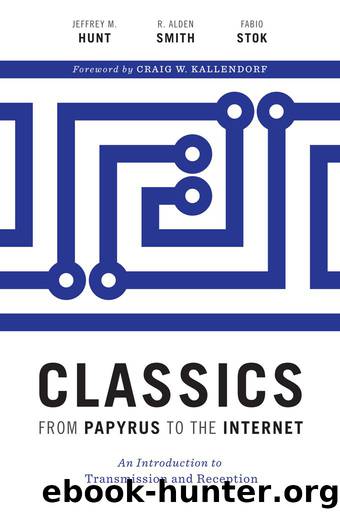Classics from Papyrus to the Internet: An Introduction to Transmission and Reception (Ashley and Peter Larkin Series in Greek and Roman Culture) by Jeffrey M. Hunt & R. Alden Smith & Fabio Stok

Author:Jeffrey M. Hunt & R. Alden Smith & Fabio Stok [Hunt, Jeffrey M.]
Language: eng
Format: azw3
Publisher: University of Texas Press
Published: 2017-07-24T16:00:00+00:00
FIGURE 4.5. Piero della Francesca, portrait of the duke of Urbino, Federico da Montefeltro (1490–1492). Tempera on panel. Florence, Uffizi Gallery.
Previously existing universities, which long remained strongholds of Aristotelian and scholastic thought, were slower to accept new humanistic ideas. In Rome’s Studium, and in those newly formed, such as Guarino’s at Ferrara, humanism became dominant toward the middle of the fifteenth century. Still, in the older universities, traditional ideas stayed tenaciously in place. Thomas More, in a letter from 1518, laments the prejudices of the Oxford dons and denounces the practice of reading the Fathers of the Church without knowing Greek:
Anyone who boasts that he can understand the works of the Fathers without an uncommon acquaintance with the languages of each and all of them will in his ignorance boast for a long time before the learned trust his judgment.145
The modern scholar Étienne Gilson (1884–1978) once wrote that the “difference between the Renaissance and the Middle Ages is not a difference by addition, but by subtraction. The Renaissance . . . is not the Middle Ages plus humans, but the Middle Ages minus God.”146 Clever as this bon mot sounds, it is not entirely true, as the idea of “Christian humanism” finds its roots in the patristic synthesis of classical culture and Christian doctrine,147 thus representing an important strand of humanistic culture. Nevertheless, Renaissance humanism, itself not explicitly anti-Christian, provided not only a stimulus for secularization148 but also an impetus for reformation. Long before the Reformation, Catholic thought, too, had offered ample stimuli for Christian humanism, which the writings of the Church Fathers anticipated.
Indeed, certain debates and ideas associated with various ecclesiastical schools of thought were echoed in the concerns of Salutati’s circle, particularly in regard to his interest in ancient pagan poets. One member of the circle provoked the wrath of the Camaldolese monk Giovanni of San Miniato (1360–1428). In 1405, Salutati responded forcefully to Giovanni’s criticism, writing in a letter, “if one searches for the truth in the poets or other pagan authors, one does not thereby cease to walk upon the streets of the Lord” (Epistulae 12. 20).149 A further attack upon Salutati came at about the same time from the Dominican monk and later cardinal Giovanni Dominici (1356–1419). Dominici responded to Salutati’s epistle with a work entitled Lucula Noctis, published in 1405, in which the prelate wrote that it is more useful for Christians to plow the ground than to read the books of the pagans.
A more aggressive attitude was assumed by Bruni against Ambrogio Traversari (1386–1439), who represented another strand of Christian humanism. Having acquired a knowledge of Greek from Chrysoloras, Traversari devoted himself to the translation of patristic texts. He also rendered the work of Diogenes Laertius, doing so only at the behest of Cosimo de’ Medici, as we learn from an epistle written by Traversari himself. In 1431 Traversari became general of the order of the Camaldolese, and in 1438–1439 was among the members of the Council of Basel-Ferrara.
In response to staunch criticism
Download
This site does not store any files on its server. We only index and link to content provided by other sites. Please contact the content providers to delete copyright contents if any and email us, we'll remove relevant links or contents immediately.
| Ancient & Classical | Arthurian Romance |
| Beat Generation | Feminist |
| Gothic & Romantic | LGBT |
| Medieval | Modern |
| Modernism | Postmodernism |
| Renaissance | Shakespeare |
| Surrealism | Victorian |
4 3 2 1: A Novel by Paul Auster(11072)
The handmaid's tale by Margaret Atwood(6870)
Giovanni's Room by James Baldwin(5891)
Big Magic: Creative Living Beyond Fear by Elizabeth Gilbert(4732)
Asking the Right Questions: A Guide to Critical Thinking by M. Neil Browne & Stuart M. Keeley(4597)
On Writing A Memoir of the Craft by Stephen King(4221)
Ego Is the Enemy by Ryan Holiday(3999)
Ken Follett - World without end by Ken Follett(3980)
The Body: A Guide for Occupants by Bill Bryson(3813)
Bluets by Maggie Nelson(3721)
Adulting by Kelly Williams Brown(3678)
Guilty Pleasures by Laurell K Hamilton(3598)
Eat That Frog! by Brian Tracy(3523)
White Noise - A Novel by Don DeLillo(3440)
The Poetry of Pablo Neruda by Pablo Neruda(3370)
Alive: The Story of the Andes Survivors by Piers Paul Read(3318)
The Bookshop by Penelope Fitzgerald(3234)
The Book of Joy by Dalai Lama(3231)
Fingerprints of the Gods by Graham Hancock(3218)
